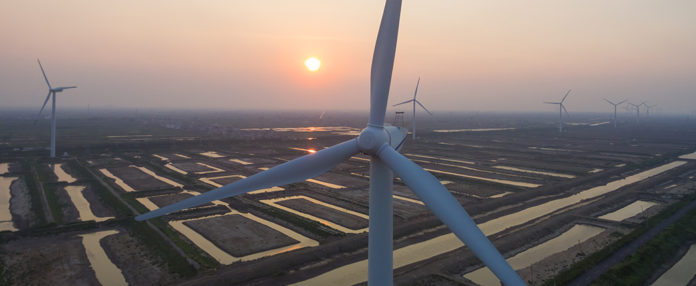
Asia-Pacific’s wind power capacity reached almost 56 gigawatts in 2020, a 78% increase from 2019, according to data released last week by the Global Wind Energy Council. China accounted for 94% of that new capacity, breaking the world record for most installed in a single year, with 52 GW.
India and Australia followed China, both with 1.1 GW of new capacity installed. Japan and Kazakhstan ranked fourth and fifth with 449 megawatts and 300 MW, respectively. A gigawatt is a unit of power equal to one billion watts, and a megawatt is equal to one million watts.
Of the 56 GW installed in the region last year, 53 GW was onshore and 3 GW offshore. China also led the world in offshore wind installations for the third consecutive year, according to the council, with over 3 GW. The only other Asia-Pacific country to record offshore wind installations last year was South Korea, with 60 MW.
Feng Zhao, head of market intelligence and strategy at the council, noted that Asia-Pacific has a bigger wind energy base than any other region. Asia-Pacific now has wind power capacity of nearly 347 GW – of which China accounts for about 83%. Europe has 219 GW, and the Americas have about 170 GW, according to the council’s 2020 data.
“The incredible and rapid growth of wind power in the region has been led by China, which now has more wind power capacity than Europe, Africa, the Middle East and Latin America combined,” Zhao said in a news release. “We were expecting an installation rush in China last year due to the phase out of the onshore wind feed-in-tariff by the end of 2020, but the Chinese wind market exceeded our original forecasts by over 73 per cent.” China’s fixed feed-in tariff for new onshore wind power plants was intended to help struggling project operators to realize profits.
The council explained that for China to achieve its goal of net zero emissions by 2060, the country needs to install more than 50 GW of wind power capacity per year from 2021 to 2025, and 60 GW per year from 2026 onwards. “Although installation levels were on track with these targets in 2020, China now must ensure that this level of growth can be sustained in a subsidy-free era,” Zhao added.
Liming Qiao, head of GWEC Asia, said the council is starting to see new wind power markets emerge in the Asia-Pacific region, “especially in Southeast Asia, which will become increasingly important growth drivers for the wind industry over the next decade. Markets such as Vietnam have massive wind power potential, but getting the right regulatory frameworks in place will be key to provide a long-term horizon for the market and attract investors.” The council’s data indicated Vietnam accounted for about 0.2% of the region’s wind energy installations last year, or about 122 MW.
“With major economies in the region, including China, South Korea, Japan, and New Zealand, setting ambitious net zero targets, both onshore and offshore wind will need to play a crucial role in helping the Asia-Pacific region achieve carbon neutrality,” he added. “This will not only help countries decarbonize, but will help create greater energy security in the region by reducing the import of expensive fossil fuels while creating opportunities for new investment and jobs.”
India added 1.1 GW of new wind power last year, according to the council, which noted in its report that 2020 was a challenging year for India’s onshore wind market. “Aside from the existing challenges of land acquisition, grid connection and permitting, the COVID-19 pandemic hit the market hard and caused delays in project construction execution,” the council noted.
Gear oils account for the majority of lubricants used in wind turbines, followed by hydraulic fluids and greases.
Gear oil is used for wind turbine gearboxes, which are eliminated in some newer direct drive turbines. Hydraulic fluid is used in the hydraulic systems that control the pitch – the angle of the blades in the wind. Grease is used in several wind turbine locations: the main rotor shaft bearing; the yaw bearing, pitch or blade bearings; pitch drive gears; and generator bearings.